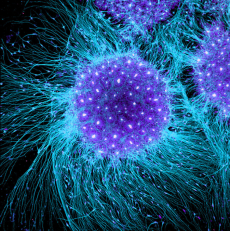

GCSE BIOLOGY REVISION: CELL BIOLOGY
Plant and animal cells (eukaryotic cells) have a cell membrane, cytoplasm and genetic material enclosed in a nucleus.
Eukaryotic cells by definition are cells that contain a nucleus and organelles and are enclosed by a cell membrane. This covers all plant and animal cells. It is important to not get ‘cell membrane’ and ‘cell wall’ confused. They are made of different materials and hold different functions. Only plant cells have a cell wall. Organelles are cell components. The genetic material that is enclosed in the nucleus is DNA (deoxyribonucleic acid.) The nucleus can be considered the control centre, it is ultimately responsible for correct cell functioning and cellular processes. Cytoplasm is the material within a living cell, excluding the nucleus. If faced with a picture of an animal and plant cell, an easy way to distinguish between the two is to look for a cell wall. Try looking up images of the two now to make yourself familiar!
Other organelles found in eukaryotic cells:
Mitochondria- These are organelles that are required for cellular respiration. They contain specific enzymes to do so, they also contain their own mitochondrial DNA. Fun fact: mitochondrial DNA always comes from your mother (never your father), therefore it is a good tool for ancestral research!
Ribosomes- These are tiny components that are the site of protein synthesis.
When a cell has all of its necessary components it can complete its function (and therefore is specialised.)
Additional organelles found in only plant cells:
Chloroplast- These are necessary for photosynthesis. They contain a green pigment called chlorophyll which absorbs sunlight. Chloroplasts also contain proteins and enzymes needed for photosynthesis.
Permanent vacuole- contains cell sap to maintain cell turgidity.
Cell wall- made of cellulose fibres for strength and support.
Something to remember: fungi cells are also eukaryotic!
Bacterial cells (prokaryotic cells) are much smaller in comparison. They have cytoplasm and a cell membrane surrounded by a cell wall. The genetic material is not enclosed in a nucleus. It is a single DNA loop and there may be one or more small rings of DNA called plasmids.
Cells of bacteria are called prokaryotic cells. Another group of organisms called Archaea are also prokaryotic. They are significantly smaller and less complex than eukaryotic cells. They were the first cells to exist on earth! Since then, cells have evolved into complex organisms. Whilst eukaryotic cells are roughly 5µm- 100µm, prokaryotic cells are mostly 0.2µm- 2µm. Different texts will say different sizes but as long as you are roughly correct the examiners will give you the marks. Prokaryotic cells have cell walls, few components (such as cytoplasm and ribosomes), and they divide by binary fission (not mitosis like eukaryotic cells.) Prokaryotic cells do not have a nucleus nor mitochondria. The DNA is free inside the cell, more DNA may be found in circles called plasmids.
image- https://www.google.co.uk/search?hl=en&biw=707&bih=760&tbm=isch&sa=1&ei=Oj2QW7GjNqmOgAbS67yQCg&q=cell&oq=cell&gs_l=img.3..35i39k1l2j0l8.1817.3003.0.3225.6.6.0.0.0.0.175.321.0j2.2.0....0...1c.1.64.img..4.2.321.0..0i67k1.0.Ck7XHN-eSDM#imgrc=C4hvAHkG51b72M:

0 Comment:
Be the first one to comment on this article.